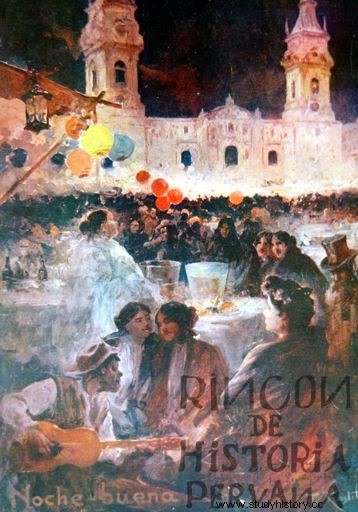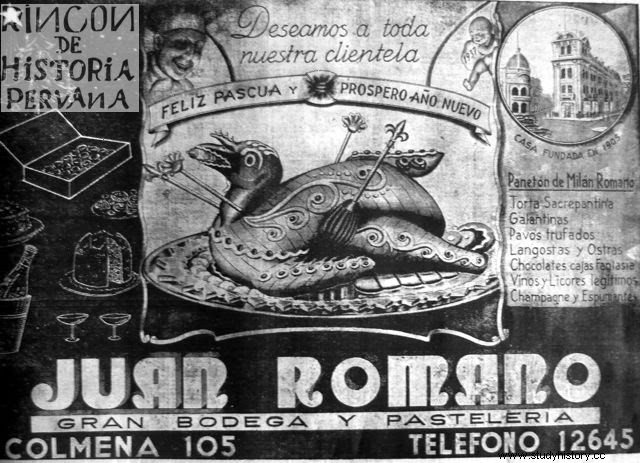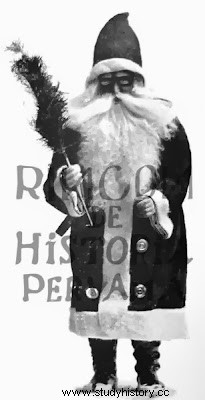UNMSM Historian
How did the ancient people of Lima celebrate Christmas? In the 19th century, Christmas was a true religious holiday, very different from the one we celebrate now. Christmas was the central celebration of a series of activities that lasted throughout the month of December, as the writer José Gálvez pointed out. “The entire month of December and part of the month of January were festive in Lima. On the 7th, the ceremonies in homage to the Immaculate Conception began. On the 13th, Saint Lucia's day, the "triguitos" were planted, essential in every birth; on the 15th the novena of the Christmas bonus began, for which in 1713 Archbishop Escandón granted an indulgence; 24, 25 and 26 were typical Christmas festivities; on the 28th the Slaughter of the Holy Innocents was commemorated; on January 1 the Circumcision was celebrated; on the 5th the Banner of the city was paraded with great solemnity, on the 6th was the great Three Kings festival, with a parade of mayors and a parade to the Pampa de Amancaes.”
(José Gálvez.Estampas limeñas.)Ricardo Palma recounts that on the afternoon of December 24, merchants set up tables in the Plaza Mayor where they sold flowers, sweets, preserves, toys, and all kinds of food. Around midnight, the crowds headed to the temples to celebrate midnight mass. These "good nights" in the main square stopped taking place in 1902, when Mayor Federico Elguera remodeled the square. The festivities were transferred to the Exposition Park where years later they stopped being celebrated.
 Christmas celebrations in the Lima of yesteryear: Image taken from Peruvian History Corner
Christmas celebrations in the Lima of yesteryear: Image taken from Peruvian History Corner Midnight Mass
It was the most important Christmas Eve liturgy, it was performed at midnight. For this mass, the churches of the city took pains to decorate their altars. The midnight mass of the church of La Merced in the jirón de la Unión was famous. The women of Lima attended this mass wearing mantillas, as in colonial times. After the mass, the crowd returned to the Plaza Mayor to continue with the celebrations. In their homes, some families celebrated Christmas dinner, depending on their social status, with dinner, drinks and dancing.
Nativity scenes
The "cribs" or births (also called mysteries) were spread by the fathers of the Bethlemite order. In the shield of this congregation you can see the nativity of Jesus. Famous nativity scenes were set up in Lima, Ricardo Palma says that the most famous one in Lima “was the one that was exhibited in the convent of the Bethlehem or bearded fathers. And it was famous for the abundance of automatic dolls and for the Christmas carols with which they celebrated the Divine Infant.” (Ricardo Palma. The month of December in the old Lima) José Gálvez mentions other famous births:The birth of the Ingunza family in the street Corcovado, was made of silver; the birth of Calle de Borricos with its realistic life-size figures and the famous birth of Button Street, in the Cercado neighborhood, owned by Mr. Carlos Cisneros, a marvel that had:"Hills and mountains covered with vegetation and that populated herds and shepherds; seas crossed by powerful merchant and war ships; cities with large buildings, squares, churches, barracks, theaters, etc., and whose streets were traveled by trams, cars and pedestrians; Biblical scenes from Paradise with Adam and Eve to the slaughter of the innocents by Herod.” (Máximo Jiménez. Nacimiento de Botones)
Another famous nativity scene was on Calle de la Peña Horadada (today Jirón Junín). According to Eudocio Carrera, this birth "reached such a peak that, during the two weeks of its duration, nothing else was talked about in Lima." (Eudocio Carrera Vergara. The Creole Lima of 900) “In the big houses, friends and relatives were invited to see the nativity scene and there was dancing, dinner and luxurious fun. In poor homes, simple people received that day everyone who wanted to see the Nativity and a saucer was placed at the door to receive alms for the "child's urine" and after the songs of Christmas carols, dances, of the pallas -indians in colorful costumes- they armed themselves with a harp and a cajon, a jarana of that kind of breaks and tears”. (José Gálvez. Christmas in Lima.) The "child's urine" was the name given to the corn chicha that was used to toast the birth. Ricardo Palma said that these visits were made from seven to eleven at night. This custom of visiting the births of each home was lost.
Christmas dinner
Christmas dinner was a true festival of flavors. In the squares of the city, itinerant tables were installed where Creole stews were offered. The costumbrista writer Hernán Velarde tells us about this great feast of flavors in his "Lima de Antaño". and nougat, and ordinary and "milk" shampoos. Purple and pork porridge, Manjarblanco, peanuts, camotillo, Picarones, fritters, custard, Alfajores from Huaura and Trujillo. Shrimp, and eggs, and potatoes, and Huacho sausages, and hams, and seviche of shells and fish, and anticuchos, sweet potatoes and suckling pigs. Demijohns, full of pisco, large plates with a hundred sausages, and torrents of various chichas, in gourds and glasses and jars.
In the squares and plazas , especially, in the main square, the tables were installed. They were true feasts where Limans from all social sectors mixed. For their part, the Italian, English and Spanish immigrants preserved their customs and prepared dinner according to their traditions. During the time of the guano boom, very opulent Christmases were spent. In the midst of the War of the Pacific and the National Reconstruction, Christmas was very sad. It is from 1895 that the country's situation improved with the government of Nicolás de Piérola. As of this year, many European customs are introduced:the Christmas tree, Santa Claus, dinner at home and the influence of European gastronomy. In the shop windows of the Jirón de la Unión, the importer stores announced:“ a great assortment of candies, chocolate chips, polished fruits, dried figs, nougat, Naples macaroni, Swiss cheese, Parmesan, Bologna tortellini and a complete assortment of preserves, wines and fine liquors of all kinds, fresh and at reasonable prices. (Diario El Comercio) The custom of decorating the Christmas table with sweets and confectionery is European, this has been preserved to this day. Abraham Valdelomar offers us another literary description of the Christmas dinner in his "Easter letter". "On the white tablecloth there was a gift dinner, although humble. An oven-roasted suckling pig, with almonds and paprika, loosely wrapped in green lettuce leaves, bananas; bunches of painted grapes, sour at sight; a golden corn empanada on fire like a goldsmith's jewel, and warm bread. From the kitchen came the scandalous smell of pork rinds, the tamales steamed in a bowl among the withered banana leaves, and the agrás punch, smelling of cinnamon and nutmeg, gleamed in a transparent pitcher. In addition, roses, carnations, jasmine, aromas and basil.”
The researcher of Peruvian gastronomy, Rosario Olivas notes that on these dates “chickens, hams and sausages” and other stews sold in the main square were consumed. all these dishes, they could not miss the tamales and pork rinds. There was no Lima Christmas without these two stews. Later, at the end of 1920, the consumption of turkey became widespread.
 Advertising the Lima of Yesteryear
Advertising the Lima of Yesteryear Panettone
The custom of eating panettone spread in the 20th century, however, in the 19th century some families in Lima already tasted the famous "Panettone of Milan" or the "Panettone a la Genovesa". In an advertisement found in the newspaper El Comercio, the Panetón Bonaspetti.F. BonaspettiExquisite, for Easter and New Year, it is sold at Bodega de la Unión, Mercaderes 195, in front of the Crevani hat shop. (El Comercio, December 16, 1898) However, it must be clarified that in the 19th century, it was not a very widespread custom among the population, these first Italian panetones were sold in the warehouses for consumption by foreign families. From 1920 the consumption of panettone was going to spread, not only foreign businesses sold it, even Chinese bakeries made this popular Christmas bread. days.
Santa Claus
Santa Claus or Father Christmas, arrives in Peru at the end of the 19th century. The journalist Federico Larrañaga wrote in 1906 that Santa Claus was born in Paris "among a snowy pine forest on the hill of Montmartre". The image of him spread in Peru at the beginning of the 20th century, he was the character who brought toys to good children. Our Santa Claus arrived from France and his image was spread on postcards and Christmas cards.
 Santa Claus
Santa Claus Image taken from Rincón de Historia Peruana
From the religious holiday to the commercial date
Over time, Christmas became a commercial date. Large stores in the jirón de la Unión, such as Casa Welsch, Oeschle, Crevani, Pigmalyon, sold gifts for ladies and gentlemen. They also sold toys for the little ones. The children's favorite toys were:carts, bugles, rag clowns, wooden horses, tin soldiers, carts, drums, dollhouses and tools. Around 1930, many of these customs are being lost and Christmas is going away. look more like the one we know today. In this small remembrance it helps us to reflect on the true meaning of Peruvian Christmas. What was in the past and what is today.
!!!!MERRY CHRISTMAS AND HAPPY NEW YEAR!!!
